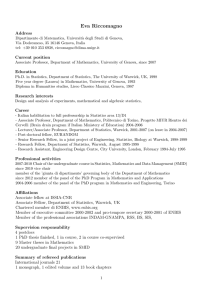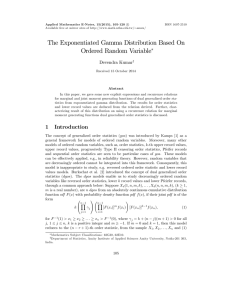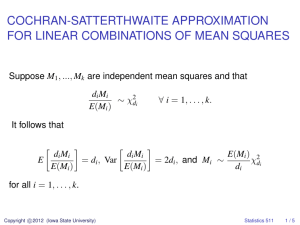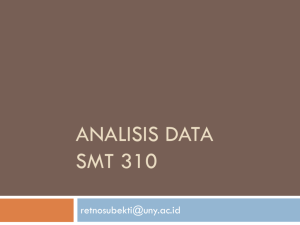Document 10677590
advertisement
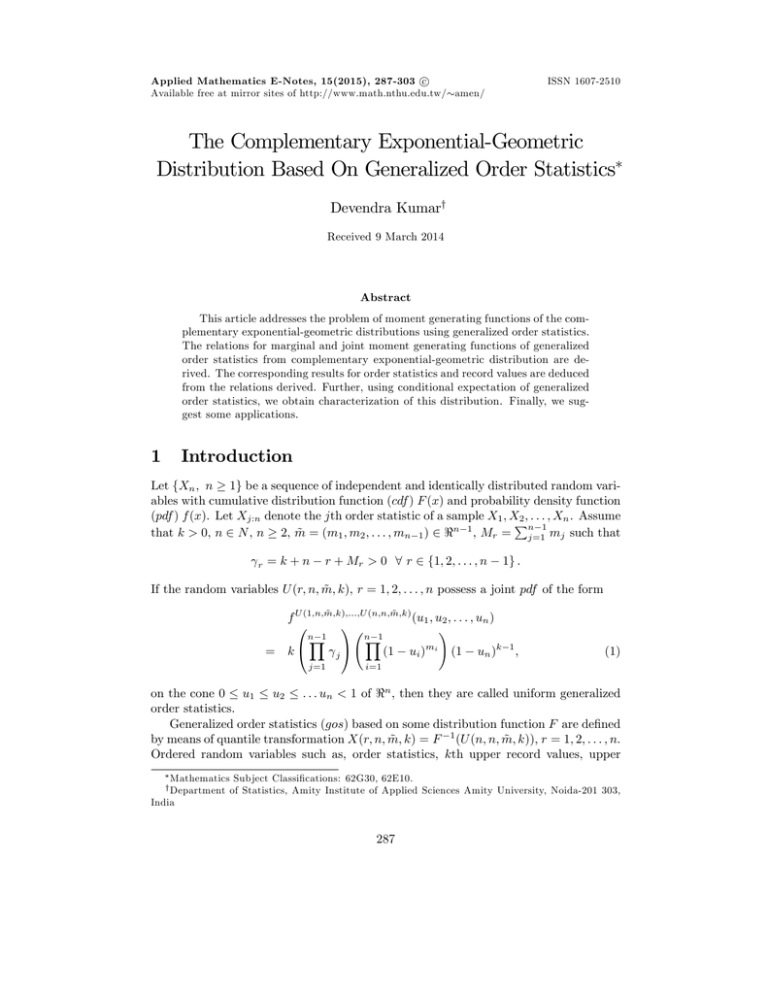
Applied Mathematics E-Notes, 15(2015), 287-303 c Available free at mirror sites of http://www.math.nthu.edu.tw/ amen/ ISSN 1607-2510 The Complementary Exponential-Geometric Distribution Based On Generalized Order Statistics Devendra Kumary Received 9 March 2014 Abstract This article addresses the problem of moment generating functions of the complementary exponential-geometric distributions using generalized order statistics. The relations for marginal and joint moment generating functions of generalized order statistics from complementary exponential-geometric distribution are derived. The corresponding results for order statistics and record values are deduced from the relations derived. Further, using conditional expectation of generalized order statistics, we obtain characterization of this distribution. Finally, we suggest some applications. 1 Introduction Let fXn ; n 1g be a sequence of independent and identically distributed random variables with cumulative distribution function (cdf ) F (x) and probability density function (pdf ) f (x). Let Xj:n denote the jth order statistic of a sample X1 ; X2 ; : : : ; Xn . Assume Pn 1 that k > 0, n 2 N , n 2, m ~ = (m1 ; m2 ; : : : ; mn 1 ) 2 <n 1 , Mr = j=1 mj such that r =k+n r + Mr > 0 8 r 2 f1; 2; : : : ; n 1g : If the random variables U (r; n; m; ~ k), r = 1; 2; : : : ; n possess a joint pdf of the form ~ (n;n;m;k) ~ f U (1;n;m;k);:::;U (u1 ; u2 ; : : : ; un ) 1 0 ! n n Y1 Y1 m i A (1 ui ) (1 un )k = k@ j j=1 1 ; (1) i=1 on the cone 0 u1 u2 : : : un < 1 of <n , then they are called uniform generalized order statistics. Generalized order statistics (gos) based on some distribution function F are de…ned by means of quantile transformation X(r; n; m; ~ k) = F 1 (U (n; n; m; ~ k)), r = 1; 2; : : : ; n. Ordered random variables such as, order statistics, kth upper record values, upper Mathematics Subject Classi…cations: 62G30, 62E10. of Statistics, Amity Institute of Applied Sciences Amity University, Noida-201 303, India y Department 287 288 The Complementary Exponential-Geometric Distribution record values, progressively Type II censoring order statistics, Pfeifer records and sequential order statistics are seen to be particular cases of gos. These models can be e¤ectively applied in many statistical applications, statistical modeling and inference involving data pertaining to economics, life testing studies, reliability theory and so on. Suppose X(1; n; m; k); : : : ; X(n; n; m; k), (k 1, m is a real number), are n gos from an absolutely continuous cumulative distribution function cdf F (x) with probability density function pdf f (x). If their joint pdf is of the form 0 1 ! n n Y1 Y1 m i A k@ [1 F (xi )] f (xi ) [1 F (xn )]k 1 f (xn ); (2) j j=1 i=1 on the cone F 1 (0) x1 x2 ::: xn F 1 (1): For convenience, let us de…ne X(0; n; m; k) = 0. It can be seen that for m1 = m2 = = mn 1 = 0 and k = 1; i.e., i = n i + 1 and 1 i n 1, this model reduces to the ordinary order statistic and (2) will be the joint pdf of n order statistics X1:n X2:n : : : Xn:n from cdf F (x). In a similar manner, choosing the parameter appropriately, some other models such as kth upper record values (m1 = = mn = 1, k 2 N , i.e., i = k, 1 i n 1), sequential order statistics (mr = (n r + 1) r (n r) r+1 1; r = 1; 2; : : : ; n 1, k = n ; 1 ; 2 ; : : : ; n > 0, i.e., i = (n i + 1) i ; i i n 1), order statistics with non-integral sample size (m1 = = mn 1 = 0, k = n+1 with n 1 < 2 <; i.e., i = i + 1; 1 i n 1) (Rohatgi and Saleh [1], Saleh et al. [2]), Preifer’s record values and progressively type-II right censored order statistics can be obtained (cf. Kamps [3, 4], Kamps and Cramer [5]). In view of (2), the marginal pdf of the r-th gos, X(r; n; m; k), 1 r n; is fX(r;n;m;k) (x) = Cr 1 [F (x)] (r 1)! r The joint pdf of X(r; n; m; k) and X(s; n; m; k), 1 = 1 r 1 f (x)gm (F (x)): r<s (3) n, is fX(r;n;m;k);X(s;n;m;k) (x; y) Cs 1 r 1 [F (x)]m f (x)gm (F (x)) (r 1)!(s r 1)! s r 1 [hm (F (y)) hm (F (x))] F (y) s for x < y where Cr 1 = r Y i, 1 m+1 (1 F (x) = 1 F (x); i=1 hm (x) = ln (1 m+1 x) x) if m 6= if m = 1; 1; 1 f (y) (4) D. Kumar 289 and gm (x) = hm (x) hm (1), x 2 [0; 1): Several authors utilized the concept of gos in their work. References may be made to Kamps and Gather [6], Keseling [7], Cramer and Kamps [8], Ahsanullah [9], AlHussaini et al. [10, 11], Kulshrestha et al. [12] among others. Kumar [13] has established recurrence relations for marginal and joint mgf of lower generalized order statistics from Marshall-Olkin extended logistic distribution. Kumar [14, 15] also established explicit expressions and some recurrence relations for mgf of kth record values from generalized logistic and extended type II generalized logistic distributions. Recurrence relations for moments of kth record values were investigated, among others, by Grudzien and Szynal [16], and Pawlas and Szynal [17, 18]. The exponential distribution is the most popular distribution for modeling many problems in life testing and reliability studies. Recently Adamidis and Loukas [19] introduced two-parameter complementary exponential-geometric (CEG) distribution lifetime distribution, which is complementary to the exponential-geometric model. For > 0 and 0 < < 1 the two-parameter CEG distribution has the pdf of the form f (x; ; ) = e [ + (1 x x ]2 )e ; x>0 (5) and the corresponding cdf is F (x; ; ) = 1 e [ + (1 x )e x] ; x > 0: (6) Here, and are the scale and shape parameters respectively. Plots of the pdf of CEG distribution for some combination of the values of the model parameters are given in Figure 1. Figure 1. CEG Density Function. The reliability function R(x), which is the probability of an item not failing prior to some time t, is de…ned by R(x) = 1 F (x). The reliability function of a CEG 290 The Complementary Exponential-Geometric Distribution distribution is given by R(x) = e [ + (1 x )e x] ; x > 0: (7) The basic tools for studying the ageing and reliability characteristics of the system are the hazard rate (HR) and the mean residual lifetime (M RL). The HR and the M RL deal with the residual lifetime of the system. The HR gives the rate of failure of the system immediately after time x, and the M RL measures the expected value of the remaining lifetime of the system, provided that it has survived up to time x. Thus the hazard rate function of the CEG distribution is given by h(x) = 1 f (x; ; ) = F (x; ; ) + (1 )e x ; x > 0: (8) Plots of the hazard function of CEG distribution for some combination of the values of the model parameters are given in Figure 2. Figure 2. CEG reliability function. A recurrence relation for moment generating functions of gos from the CEG distribution is obtained by making use of the following (obtained from (5) and (6)) F (x; ; ) = + (1 )e x f (x; ; ): (9) Let us denote the marginal mgf of X(r; n; m; k) by MX(r;n;m;k) (t) and its jth derivative (j) by MX(r;n;m;k) (t). Similarly, let MX(r;n;m;k);X(s;n;m;k) (t1 ; t2 ) denote the joint mgf of X(r; n; m; k) and X(s; n; m; k) and its (i; j)th partial derivatives by (i;j) MX(r;n;m;k);X(s;n;m;k) (t1 ; t2 ) D. Kumar 291 with respect to t1 and t2 , respectively. Figure 3. CEG reliability function. The presentation of the content of this work is as follows: In Section 2, we present some explicit expressions and recurrence relations for marginal mgf of gos from CEG distribution. We obtain the relations for joint mgf of gos from this distribution in Section 3. We also present recurrence relations for the moments so that one can obtain the higher order moments from those of the lower order. In Section 4, we obtain a characterization result of this distribution by using conditional expectation of gos. In Section 5, three applications are demonstrated to illustrate the utility of the results derived in Sections 2 and 3. Section 6 ends with concluding remarks. 2 Relations for Marginal Moment Generating Functions For the CEG distribution given in (5), the mgf of X(r; n; m; k) is given as Z 1 etx fX(r;n;m;k) (x)dx MX(r;n;m;k) (t) = 1 Z 1 Cr 1 r 1 etx [F (x)] r 1 f (x)gm (F (x))dx: = (r 1)! 1 (10) Further, by using the binomial expansion, we can rewrite (10) as MX(r;n;m;k) (t) = (r Z Cr 1 1)!(m + 1)r 1 etx [F (x)] 1 r 1 X r ( 1)u u=0 r u 1 1 u f (x)dx: (11) 1 Now letting z = F (x) in (11), we get 1 X r 1 X Cr 1 ( 1)u+p 1)!(m + 1)r p=0 u=0 t= MX(r;n;m;k) (t) = (r r 1 u p! 1+ t 1+ t p 292 The Complementary Exponential-Geometric Distribution k +n m+1 )p B (1 r+u+ p (t= ) ; 1 : m+1 (12) Since b X b a ( 1)a a=0 B(a + k; c) = B(k; c + b); (13) where B(a; b) is the complete beta function, we have MX(r;n;m;k) (t) = 1 X p=0 t= ( 1)p p! t 1+ p (1 )p Qr a=1 t 1+ 1+ : p (t= ) (14) a Special cases i) Putting m = 0 and k = 1 in (14), the explicit formula for mgf of order statistics from the CEG distribution can be obtained as t= MXr:n (t) = (n 1 n! X ( 1)p (1 r)! p=0 p! and t= MX1:n (t) = n )p 1+ 1+ p t 1 X ( 1)p (1 p! 1 + t p=0 t n r+1+p n+1+p t )p 1+ p n+p t ; t t for r = 1: ii) Setting m = 1 in (14), we get the explicit expression for the marginal mgf of kth upper record values from the CEG distribution MX(r;n; 1;k)(t) = 1 X ( 1)p (1 p! p=0 and MXU (r) = 1 X ( 1)p (1 p! p=0 1+ 1+ t p t= )p t )p p 1+p t= 1+ 1+ p (t= ) k 1+ t t r t r ; for r = 1: A recurrence relation for the marginal mgf for gos from (9) can be obtained in the following theorem. THEOREM 1. For the distribution given in (5) and for 2 k = 1; 2; : : : ; 1 t r 2; MX(r;n;m;k) (t) (j) MX(r 1;n;m;k) (t) (1 n, n (j) r = r )h (j) + j (j 1) r MX(r;n;m;k) (t) tMX(r;n;m;k) (t (j 1) ) + jMX(r;n;m;k) (t i ) : (15) D. Kumar 293 PROOF. From (3), we have Z Cr 1 (r 1)! (j) MX(r;n;m;k) (t) = 1 etx [F (x)] r 1 r 1 f (x)gm (F (x))dx: (16) 1 Integrating by parts of (16) and by (9), we get M(r;n;m;k) (t) = MX(r 1;n;m;k) (t) + t M(r;n;m;k) (t) r + t(1 ) M(r;n;m;k) (t ): (17) r Di¤erentiating both sides of (17) j times with respect to t, we get the result given in (15). By di¤erentiating both sides of equation (15) with respect to t and then setting t = 0, we obtain the recurrence relations for moments of gos from CEG in the form E[X j (r; n; m; k)] = E[X j (r 1; n; m; k)] + j E[X j 1 (r; n; m; k)] r + j(1 ) E[ (X(r; n; m; k))]; (18) r where (x) = xj 1 e x : REMARK 1. Putting m = 0 and k = 1 in (15) and (18), we can get the following relations for order statistics 1 t r + 1) (n (j) = MXr + j (j 1) M (t) (n r + 1) Xr:n h (1 ) (j) (j 1) tMXr:n (t ) + jMXr:n (t (n r + 1) 1:n (t) + and j E[Xr:n ] = E[Xrj 1:n ] + REMARK 2. Setting m = values can be obtained as 1 t k M (j) (k) Zr (t) = j r + 1) (n 1 and k M + and (j) MXr:n (t) (j) (k) 1 Zr j 1 E[Xr:n ]+ 1 ) i E[ (Xr;n )] : 1 in (15) and (18), relations for record j (j 1) M (t) k Zr(k) ) h (j) (j 1) tM (k) (t ) + jM (k) (t (t) + (1 k Zr Zr i ) 294 The Complementary Exponential-Geometric Distribution (k) j 1) ] E[(Zr(k) )j ] = E[(Zr j k + E[(Zr(k) )j 1 ]+ 1 E[ (Zr )] ; and hence for upper records, E[XUj (r) ] = E[XUj (r 1) ] + j 1 1 ]+ E[XUj (r) E[ (XU (r) )] : REMARK 3. The relation in (18) can be used in a simple recursive process to obtain all the rth single moments of generalized order statistics for j 2 Z + , (Z + is the set of positive integer values). The computations of these moments can be done based on the rth single moment of the order statistics and record value. 3 Relations for Joint Moment Generating Functions For CEG distribution, the joint mgf of X(r; n; m; k) and X(s; n; m; k) is given as Z 1Z 1 MX(r;n;m;k);X(s;n;m;k) (t1 ; t2 ) = et1 x+t2 y fX(r;n;m;k)X(s;n;m;k) (x; y)dxdy: 1 x By (4) and binomial expansion, we have MX(r;n;m;k);X(s;n;m;k) (t1 ; t2 ) Cs 1 = (r 1)!(s r 1)!(m + 1)s r 1 r 1 sX X ( 1)u+v u=0 v=0 Z 1 t1 x e [F (x)](s r 2 1 s u r+u v)(m+1) 1 r v 1 f (x)G(x)dx; (19) 0 where G(x) = Z 1 et2 y [F (y)] s v 1 f (y)dy: (20) x By setting z = F (y) in (20), we obtain t2 = G(x) = 1 X ( 1)p (1 )p p! 1 + t2 p=0 1+ p t2 s [F (x)] v +p s v+p t2 (t2 = ) : On substituting the above expression of G(x) in (19) and simplifying the resulting equation, we get MX(r;n;m;k);X(s;n;m;k) (t1 ; t2 ) (t1 +t2 )= = (r 1)!(s r Cs 1 1)!(m + 1)s 2 D. Kumar 295 1 X 1 X ( 1)p+q (1 )p+q p!q! 1 + t2 p p=0 q=0 r 1 X r ( 1)u 1 B u u=0 sX r 1 s ( 1)v v=0 r v 1 + t2 1 + t1 k +n m+1 1 B 1+ q r+u+ k +n m+1 t1 p+q s+v+ (t1 + t2 )= ;1 m+1 p (t2 = ) ; 1 : (21) m+1 By relation (13) in (21), and after simpli…cation we get = MX(r;n;m;k);X(s;n;m;k) (t1 ; t2 ) 1 X 1 X ( 1)p+q (1 )p+q p=0 q=0 p!q! 1+ t2 1 + t2 1 + t1 p 1+ q t1 (t1 +t2 )= Qr a=1 1+ p+q (t1 +t2 )= a Qs b=r+1 1+ : p (t2 = ) (22) b Special Cases i) Putting m = 0 and k = 1 in (22), the explicit formula for joint mgf of order statistics can be obtained as MXr:n ;Xs:n (t1 ; t2 ) 1 1 (t1 +t2 )= )p+q n! X X ( 1)p+q (1 = (n s)! p!q! 1 + t2 p p=0 q=0 1 + t2 1 + t1 1+ q t1 [n r + 1 + p + q (t1 + t2 )= ] [n s + 1 + p (t2 = )] : [n + 1 + p + q (t1 + t2 )= ] [n r + 1 + p (t2 = )] ii) Setting m = 1 in (22), we deduce the explicit expression for joint mgf of upper record value in the form MXU (r) ;XU (s) (t1 ; t2 ) = 1 1 X X ( 1)p+q (1 )p+q p!q! 1 + t2 p p=0 q=0 1 + t2 1 + t1 1+ q t1 (t1 +t2 )= 1+ p+q (t1 +t2 )= k r 1+ p (t2 = ) k s r: By (9), we can derive the recurrence relations for the joint mgf of gos. THEOREM 2. Let X(1; n; m; k); : : : ; X(n; n; m; k) be n gos formed from a random sample of size n from the pdf (5). Then for 1 r <s n , n 2 and k 1 the following recurrence relation is satis…ed 1 t2 (i;j) s MX(r;n;m;k)X(s;n;m;k) (t1 ; t2 ) 296 The Complementary Exponential-Geometric Distribution (i;j) = MX(r;n;m;k)X(s 1;n;m;k) (t1 ; t2 ) + (1 s )h (i;j) t2 MX(r;n;m;k)X(s;n;m;k) (t1 ; t2 ) i j (i;j 1) ) + MX(r;n;m;k)X(s;n;m;k) (t1 ; t2 ): (23) (i;j 1) + jMX(r;n;m;k)X(s;n;m;k) (t1 ; t2 s PROOF. Using (4), the joint mgf of X(r; n; m; k) and X(s; n; m; k) is given by MX(r;n;m;k)X(s;n;m;k) (t1 ; t2 ) Z 1 Cs 1 r 1 = [F (x)]m f (x)gm (F (x))I(x)dx (r 1)!(s r 1)! 0 and I(x) = Z 1 et1 x+t2 y [hm (F (y)) hm (F (x))]s r 1 [F (y)] s 1 (24) f (y)dy: x Solving the integral in I(x) by parts and using (9), substituting the resulting expression in (24), we get MX(r;n;m;k)X(s;n;m;k) (t1 ; t2 ) = MX(r;n;m;k)X(s 1;n;m;k) (t1 ; t2 ) + t2 MX(r;n;m;k)X(s;n;m;k) (t1 ; t2 ) s + (1 ) MX(r;n;m;k)X(s;n;m;k) (t1 ; t2 ) : (25) Di¤erentiating both sides of (25) i times with respect to t1 and then j times with respect to t2 and simplifying the resulting expression, we get the result given in (23). One can also note that Theorem 1 can be deduced from Theorem 2 by letting t1 tends to zero. By di¤erentiating both sides of equation (23) with respect to t1 , t2 and then setting t1 = t2 = 0 , we obtain the recurrence relations for product moments of gos from CEG in the form E[X i (r; n; m; k)X j (s; n; m; k)] = E[X i (r; n; m; k)X j (s 1; n; m; k)] j + E[X i (r; n; m; k)X j 1 (s; n; m; k)] s + (1 ) E[ (X(r; n; m; k)X j (s 1; n; m; k))] ; (26) where (x; y) = xi y j 1 e y : REMARK 4. Putting m = 0 and k = 1 in (23) and (26), we obtain the recurrence relations for joint mgf and single moments of order statistics in the form 1 t2 (n s + 1) (i;j) MXr;s:n (t1 ; t2 ) D. Kumar 297 (i;j) = MXr;s 1:n (t1 ; t2 ) + j (i;j 1) M (t1 ; t2 ) s + 1) Xr;s:n (n h (1 ) (i;j) t2 MXr;s:n (t1 ; t2 (n s + 1) + (i;j 1) ) + jMXr;s:n (t1 ; t2 ) i and i;j i;j E[Xr;s:n ] = E[Xr;s 1:n ] + (n j s + 1) i;j 1 E[Xr;s:n ]+ 1 E[ (Xr;s:n )] : REMARK 5. Substituting m = 1 and k 1 in (23) and (26), we get recurrence relation for joint mgf and product moments of the kth upper record values for CEG distribution. 4 Characterization Let X(r; n; m; k), r = 1; 2; : : : ; n be gos. Then from a continuous population with cdf F (x) and pdf f (x), then the conditional pdf of X(s; n; m; k) given X(r; n; m; k) = x, 1 r < s n, in view of (5) and (6), is fX(s;n;m;k)jX(r;n;m;k) (yjx) = Cs 1 r 1)!Cr (s [hm (F (y)) 1 hm (F (x))]s [F (x)] r+1 r 1 [F (y)] s 1 f (y): (27) THEOREM 3. Let X(r; n; m; k), r = 1; 2; : : : ; n be gos based on continuous distribution function F (x) with F (0) = 0 and 0 < F (x) < 1 for all x > 0: Then the conditional expectation of gos X(s; n; m; k) given X(r; n; m; k) = x, is given as E[etX(s;n;m;k) jX(r; n; m; k) = x] t= = sYr j=1 1 X ( 1)p (1 )p p! 1 + t p=0 r+j r+j +p (t= ) 1+ p t e + (1 )e : e [ + (1 x )e PROOF. From (27), we have = x (28) if, and only if, F (x; ; ) = 1 p (t= ) x E[etX(s;n;m;k) jX(r; n; m; k) = x] Cs 1 (s r 1)!Cr 1 (m + 1)s r 1 x] ; x > 0: 298 The Complementary Exponential-Geometric Distribution Z 1 e ty x By setting w = F (y) F (x) " # m+1 s r 1 F (y) F (x) 1 1 s F (y) F (x) f (y) dy: F (x) (29) from (6) in (29), we obtain h i E etX(s;n;m;k) jX(r; n; m; k) = x t= = (s r 1)!Cr Cs 1 s 1 (m + 1) 1 X ( 1)p (1 )p p! 1 + t p=0 Z 1 w s +p (t= ) 1 (1 r 1 1+ p t wm+1 )s r 1 p (t= ) x e + (1 x )e dw: (30) 0 Again by setting z = wm+1 in (30) and simplyfying the resulting expression, we get the result given in (28). To prove su¢ ciency, we have from (27) and (28) Z 1 Cs 1 ety [(F (x))m+1 (F (y))m+1 ]s r 1 (s r 1)!Cr 1 (m + 1)s r 1 x [F (y)] 1 s f (y)dy = [F (x)] r (x); r+1 (31) where r (x) t= = 1 X ( 1)p (1 )p p! 1 + t p=0 e + (1 x x )e 1+ p p (t= ) sYr t r+j r+j j=1 +p : (t= ) Di¤erentiating (31) both sides with respect to x and rearranging the terms, we get (s Z Cs 1 [F (x)]m f (x) r 2)!Cr 1 (m + 1)s 1 ety [(F (x))m+1 r 2 (F (y))m+1 ]s r 2 [F (y)] s 1 f (y)dy x = 0 r (x)[F (x)] r+1 r+1 r (x)[F (x)] r+1 1 f (x) or r+1 r+1 (x)[F (y)] r+2 +m Therefore, f (x) = F (x) f (x) = 0 r (x)[F (x)] 0 r (x) r+1 [ r+1 (x) r (x)] r+1 = r+1 r (x)[F (x)] [ + (1 )e x] ; r+1 1 f (x): D. Kumar 299 which proves that F (x; ; ) = 1 e [ + (1 x )e x] ; x > 0: REMARK 6. For m = 0, k = 1 and k = 1, m = 1, we obtain the characterization results of the CEG distribution based on order statistics and record values, respectively. 5 Numerical Results In Tables 1–4, we have computed the values of means for = 0:5(0:5)4 and = 0:5; 1:0. From Tables 1 and 2, one can see that the mean of order statistics is increasing with respect to but decreasing with respect to r; n and . Also from Tables 3 and 4 one can see that the means of record values are increasing with respect to and r but decreasing with respect to . In Tables 5–8, we have computed the variances of order statistics and record values for di¤erent values of r; s and n for di¤erent values of and . The numerical computation for the skewness, kurtosis and covariances of order statistics and record values are not presented here but they are available from the author on request. 6 Applications The recurrence relations for moments of ordered random variables are important because they reduce the amount of direct computations for moments, evaluate the higher moments and they can be used to characterize distributions. The recurrence relations of higher joint moments enable us to derive single, product, triple and quadruple moments which can be used in Edgeworth approximate inference. The explicit expressions given in Sections 2 and 3 can be used to calculate the means, variances, skewness, kurtosis and variance covariance matrix. 7 Concluding Remarks In this paper, we considered the gos from CEG model and obtained exact explicit expressions as well as recurrence relations for the marginal and joint moment generating functions of gos. The recurrence relations obtained in the paper allow us to evaluate the means, variances and covariances of all order statistics and upper record values for all sample sizes in a simple recursive manner. However, we have only computed the means and variances of the order statistics and record values which are useful in determining best linear unbiased estimators (BLUEs) of location/scale parameters and best linear unbiased predictors (BLUPs) of censored failure times. 300 The Complementary Exponential-Geometric Distribution Table 1: Means of order statistics for = 0:5: Table 2: Means of order statistics for = 1:0: Table 3: Means of record statistics for = 0:5: D. Kumar 301 Table 4: Means of record statistics for = 1:0: Table 5: Variances of order statistics for = 0:5: Table 6: Variances of order statistics for = 1:0: 302 The Complementary Exponential-Geometric Distribution Table 7: Variance of record statistics for = 0:5: Table 8: Variance of record statistics for = 1:0: Acknowledgment. The author is grateful to anonymous referees and the Editor for very useful comments and suggestions. References [1] V. K. Rohatgi and A. K. Md. E. Saleh, A class of distributions connected to order statistics with nonintegral sample size, Comm. Statist. Theory Methods, 17(1988), 2005–2012. [2] A. K. Md. E. Saleh, C. Scott and D. B. Junkins, Exact …rst and second order moments of order statistics from the truncated exponential distribution, Naval Res. Logist. Quart., 22(1975), 65–77. [3] U. Kamps, A Concept of Generalized Order Statistics, Teubner Skripten zur Mathematischen Stochastik. [Teubner Texts on Mathematical Stochastics] B. G. Teubner, Stuttgart, 1995. 210 pp. [4] U. Kamps, A concept of generalized order statistics, J. Statist. Plann. Inference, 48(1995), 1–23. [5] U. Kamps and E. Cramer, On distribution of generalized order statistics, Statistics, 35(2001), 269–280. D. Kumar 303 [6] U. Kamps and U. Gather, Characteristic property of generalized order statistics for exponential distribution, Appl. Math. (Warsaw), 24(1997), 383–391. [7] C. Keseling, Conditional distributions of generalized order statistics and some characterizations, Metrika, 49(1999), 27–40. [8] E. Cramer and U. Kamps, Relations for expectations of functions of generalized order statistics, J. Statist. Plann. Inference, 89(2000), 79–89. [9] M. Ahsanullah, Generalized order statistics from exponential distribution, J. Statist. Plann. Inference, 85(2000), 85–91. [10] E. K. Al-Hussaini, A. A. Ahmad and M. A. Al-Kashif, Recurrence relations for joint moment generating functions of generalized order statistics based on mixed population, J. Statist. Theory Appl., 6(2005), 134–155. [11] E. K. Al-Hussaini, A. A. Ahmad and M. A. Al-Kashif, Recurrence relations for moment and conditional moment generating functions of generalized order statistics, Metrika, 61(2007), 199–220. [12] A. Kulshrestha, R.U. Khan and D. Kumar, Relations for marginal and joint moment generating functions of Erlang-truncated exponential distribution generalized order statistics and characterization, Open J. Stat., 2(2012), 557–564. [13] D. Kumar, Relations for marginal and joint moment generating functions of Marshall-Olkin extended logistic distribution based on lower generalized order statistics and characterization, Amer. J. Math. Management Sci., 32(2013), 19– 39. [14] D. Kumar, Recurrence relations for marginal and joint moment generating functions of generalized logistic distribution based on lower record values and its characterization, ProbStat Forum, 5(2012), 47–53. [15] D. Kumar, On relations for the moment generating functions from extended type II generalized logistic distribution based on kth record values and a characterization, Jordan J. Math. Stat., 7(2014), 257–271. [16] Z. Grudzień and D. Szynal, Characterization of continuous distributions via moments of kth record values with random indices, J. Appl. Statist. Sci., 5(1997), 259–266. [17] P. Pawlas and D. Szynal, Relations for single and product moments of th record values from exponential and Gumbel distributions, J. Appl. Statist. Sci., 7(1998), 53–61. [18] P. Pawlas and D. Szynal, Recurrence relations for single and product moments of kth record values from Pareto, generalized Pareto and Burr distributions, Commun. Statist. Theor. Meth., 28(1999), 1699–1709. [19] K. Adamidis and S. Loukas, A lifetime distribution with decreasing failure rate, Statist. Probab. Lett., 39(1998), 35–42.
